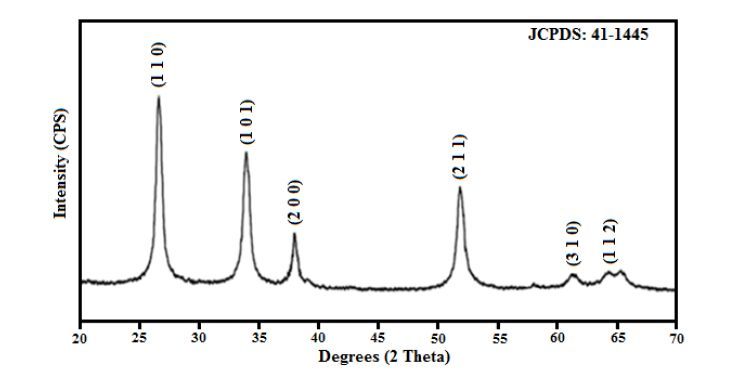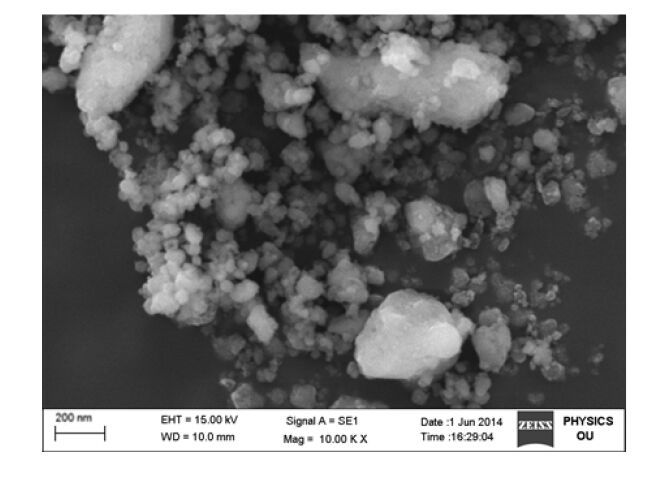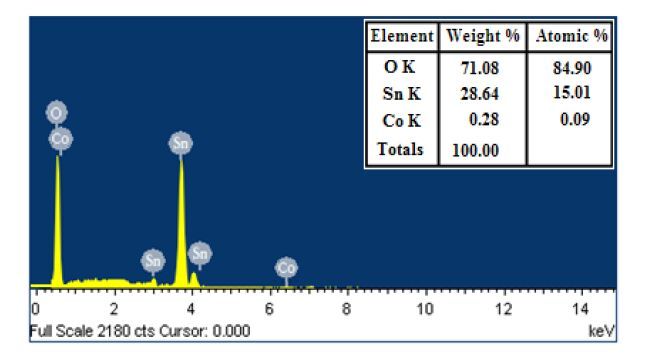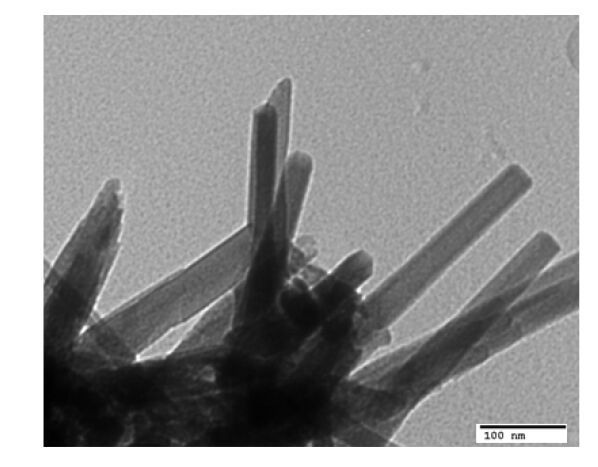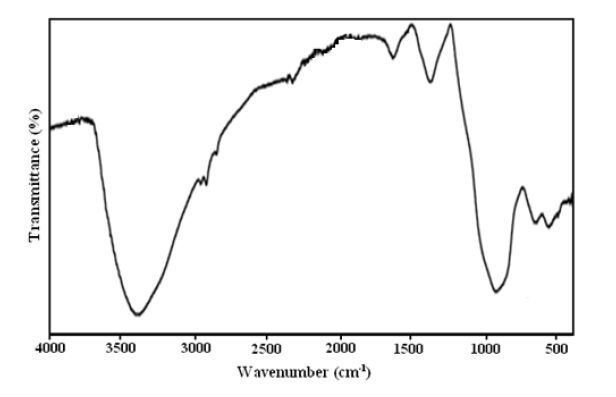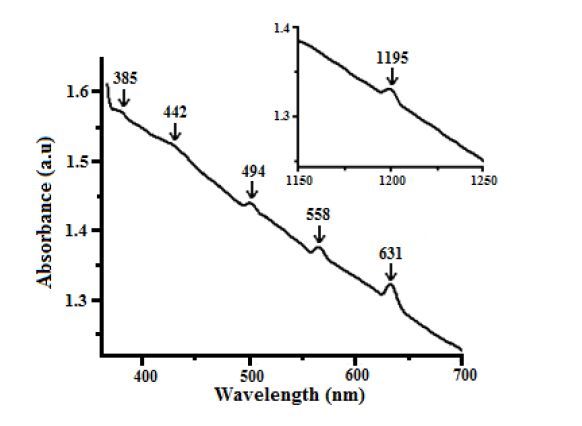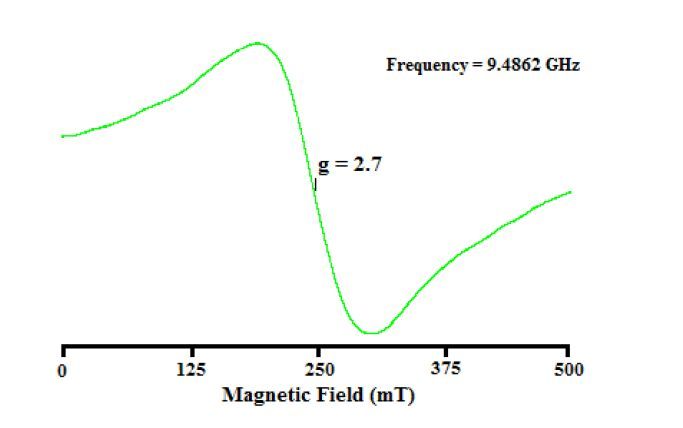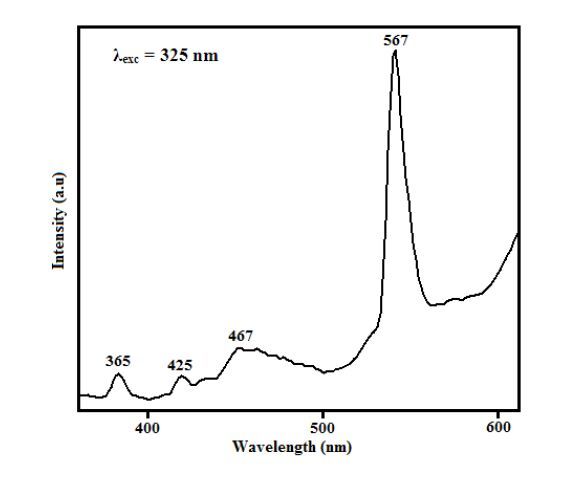The wide variety of electronic and chemical properties of metal oxides makes them exciting materials for basic research and for technological applications alike. Oxides span a wide range of electrical properties from wide band-gap insulators to metallic and superconducting. Tin oxide belongs to a class of materials called Transparent Conducting Oxides (TCO) which constitutes an important component for optoelectronic applications. Co2+ doped tin oxide thin films were prepared by chemical spray pyrolysis synthesis and characterized by powder X-ray diffraction, SEM, TEM, FT-IR, optical, EPR and PL techniques to collect the information about the crystal structure, coordination/local site symmetry of doped Co2+ ions in the host lattice and the luminescent properties of the prepared sample. Powder XRD data revealed that the crystal structure belongs to tetragonal rutile phase and its lattice cell parameters are evaluated. The average crystallite size was estimated to be 26 nm. The morphology of prepared sample was analyzed by using SEM and TEM studies. Functional groups of the prepared sample were observed in the FT-IR spectrum. Optical absorption and EPR studies have shown that on doping, Co2+ ions enter in the host lattice as octahedral site symmetry. PL studies of Co2+ doped SnO2 thin films exhibit blue and yellow emission bands. CIE chromaticity coordinates were also calculated from emission spectrum of Co2+ doped SnO2 thin films.
1.
Introduction
Periodic behavior is essential to our life. The mathematical modeling of real-life problems mainly arises in functional equations, such as partial differential equations, ordinary differential equations, and integro-differential equations. It is a matter of the fact that periodic solutions can be created or destroyed only at infinity, or their stability can change. Such qualitative changes in the dynamics are called bifurcation. It is also possible for pairs of limit cycles (one stable and one unstable) to coalesce and vanish in a codimension two generalized Hopf bifurcation (see Guckenheimer and Holmes [1]). Many of these functions have the ability to adopt bifurcation, with which we can check the stability. If all the periodic solutions come out of the origin, then these are unstable, otherwise stable (isolated closed trajectory in periodic behavior). Stable limit cycles are an example of attractors. By the Jordan curve theorem, every closed trajectory divides the plane into two regions, an interior region bounded by the curve and an exterior containing all of the nearby and far away exterior points, so that every continuous path connecting a point of one region to a point of the other intersects with that loop somewhere. In the present article, we are mainly concerned with the nonlinear system because trajectories do not simply need to approach or leave a single point. They might even approach a large set, like a circle or another closed curve. It is a fact that limit cycles are a nonlinear phenomenon; because the linear system x′=Ax may have closed orbits, they would not be isolated, such that if they have a periodic solution x(t), then all constant multiples should be, see also [2].
In engineering, power engineering, we can exploit oscillators for timing and sequencing. We can use them in locomotion control in robots. Van der Pol oscillator comes up in electrical circuits; it is an example of relaxation oscillation. Its equation is x′′−μ(1−x2)x′+x=0, where μ is a positive constant. If μ=1, then trajectories fastly settle on a closed curve, while for μ=0, all trajectories become a circle. In analyzing nonlinear systems in the xy-plane, we have so far concentrated on analyzing how the system's trajectories look in the neighborhood of each critical point.
We also observed periodic behavior in our body like; heartbeats, breathing, chewing, locomotion, diverse rhythms inside the brain, etc. More generally in walking, which is also a periodic, a passive stable limit cycle exists. as shown in Figure 1, see [3] for more details.
Consider the system of the form:
where aw and bw are homogenous polynomials having degree w. The polar form of (1.1) is written as following:
Where x and y are polynomials in cosθ and sinθ with degree (w+1). In Lloyd [4], it is presented that if:
Then the Eq (1.3) can be transformed to non-autonomous first order differential equation as:
where
and
Here κ & ρ are homogeneous polynomials in sinθ and cosθ.
We structured the paper as follows. In Section 2, we have discussed the transformation and some essential formulae to calculate periodic multiplicity. In Section 3, we recall some lemma and theorems for the origin. The significant results and conclusions are discussed in Sections 4 and 5 accordingly.
2.
First order cubic system
In the present article, we are considering the differential equation given as:
Where the coefficients κ,ρ,υ and involved variable are real-valued functions and U∈C. This paper's central result is the determination of possible maximum periodic solutions with perturbation of the coefficients on the plane. This equation is the part of the following equation, described in [5]:
With ρ0(τ)=1. For n=3, the Eq (2.2) is known as Abel's differential equation, we focused on it because of its connection with the second part of Hilbert 16th problem (maximal number of limit cycles and their relative locations of planar polynomial real vector fields of given degree); it is related to ODEs and dynamical systems. The fascination of the problem comes from the fact that it sits at the confluence of analysis, algebra, geometry and even logic. It is known, for instance, that when ρ3(t) does not change sign, the upper bound for the number of limit cycles is 3, see [6,7]. When ρ3(t)≡1 this upper bound also holds taking into account complex limit cycles, see [5,8]. In [6], we see that when ρ0(t)≡0 and ρ2(t) does not change sign, the maximum number of limit cycles of Abel's equation is also 3. We likewise refer reader to the articles [9,10,11], for additional data with respect to this issue. For the Eq (2.1), we are considering a complex dependent variable, so that the number of zeros of a function in a bounded region of the complex plane can't be changed by any small perturbations. We substitute υ(τ) ˜= 0 in (2.1), as was in [12]. Consequently, the Eq (2.1) becomes as:
Here κ and ρ may be polynomials in (i) τ (ii) cosτ and sinτ, for more detail see [12,13]. Also suppose that ∃ β∈R such that:
For U=0, the method for computing multiplicity "μ" is explained in [9,10,12,14,15]. For t in [0,β] and c small, let
Since U(0,0,c)=c, we have ξ1(0)=1 and ξi(0)=0 for i>1. The solution U=0 is a centre for the Eq (2.3) if all the solutions are periodic for c in neighborhood of 0. The solution U=0 is a centre if ξ1(β)=1 and ξi(β)=0 for i>1. Substituting the Eq (2.4) in the Eq (2.3) and equating coefficients of c yields ⋅ξ1(τ)=0. Hence, ξ1(τ)=1. Moreover, the functions ⋅ξi(τ), for i>1 are obtained with the help of following equation:
With ξ1(τ)=1. Expect to be that ϰi= ξi(β), at that point ϰ=i if ϰ1=1 and ϰk=0 for 2≤k≤i−2 but ϰi≠0, shown in Theorem 2.1. Alwash in [12], presented ξi(τ) and ϰi for i≤8, for i=9 are in [16], for i=10 we calculated ξ10(τ) and ϰ10 in [9], also presented in Theorem 2.1.
The following Theorem is the modification of Theorem 2 in [12], with the help of this Theorem periodic multiplicity is calculated. Here, in integral; ∫κ(τ)¯ρ(τ)dτ, bar "−" function is like ¯ρ(τ)=∫ρ(τ)dτ.
Theorem 2.1. The solution U=0 of the Eq (2.3) has a multiplicity k, wherever 2≤k≤10 if ϰn=0 for 2≤n≤k−1 and ϰn≠0 where
ϰ2=∫β0ρ,
ϰ3=∫β0κ,
ϰ4=∫β0κ¯ρ,
ϰ5=∫β0κ¯ρ2,
ϰ6=∫β0(κ¯ρ3−12¯κ2ρ),
ϰ7=∫β0(κ¯ρ4+2κ¯ρ2¯κ),
ϰ8=∫β0(κ¯ρ5+3κ¯ρ3¯κ+κ¯ρ2¯¯ρκ−12¯κ3ρ),
ϰ9=∫β0(κ¯ρ6−5κ¯ρ4¯κ−2¯ρ3¯ρ¯κ+20¯ρ¯κ2+2¯ρ¯κρ¯κ2),
and
ϰ10=∫β0(κ¯ρ7−12356¯κκ¯ρ5−9703κ¯κ2¯ρ3−237ρ¯ρ2¯κ3−24κ¯κ2ρ¯ρ2−70¯ρ3κ2¯κ−21¯κ4ρ−74κ¯κ3¯ρ+52¯κ2ρ¯ρ4+32¯ρ4κ¯ρ¯κ−16¯ρ4ρ¯κ−15¯ρ5κ2−36¯ρρ¯κ2¯ρ¯κ−8ρ¯ρ4κ¯κ).
3.
Conditions for centre
For U=0 as a centre, conditions that are useful for calculating maximum multiplicity ϰk, 2≤k≤10 are from [12] and are defined below.
Theorem 3.1. Consider that f, g are continuous functions defined on interval I=δ([0,β]) and a differentiable function δ with δ(β)=δ(0) such that:
then origin is the centre for the Eq (2.3).
Corollary 3.1. If κ is a constant multiple of ρ and ∫β0ρ(τ)dτ=0, then the origin is a centre for the Eq (2.3).
Corollary 3.2. If any ρ or κ is identically zero and other has mean value zero then the origin is a centre.
Remark 1. In [12], bifurcation method is described that when the coefficients of ρ(τ) and κ(τ) are slightly perturbed, two periodic solutions bifurcate out of the origin, when bifurcation method is applied. For the number of real periodic solutions, we conclude that if multiplicity μ is even, the origin is stable ϰμ<0 and unstable if ϰμ>0. If μ is odd, then the origin is stable on the right and unstable on the left if ϰμ<0; however, if ϰμ>0, the origin is stable on the left and unstable on the right.
4.
Results
4.1. Polynomial coefficients
This section describes the method for computing the maximum number of limit cycles of a polynomial differential equation in a plane for various classes of different degrees. Suppose Cr,q indicates the class for the Eq (2.3), with degree r, q for κ(τ) and ρ(τ) accordingly, for more examples see [9,10,13,14,17]. The confirmation of the accompanying theorems, stems from papers in [12,18]. We use Theorem 2.1 with β=1, as is done in Lloyd et al. If we use all coefficients for polynomials κ(τ) and ρ(τ) then we can easily see that the periodic solutions greater than 4 can't obtained. So, some possible suitable coefficients are restricted in the following classes to find as many periodic solutions as possible. All calculations regarding the different classes are carried out using Maple 18.
Theorem 4.1. Suppose the class C9,4 for the Eq (2.3), if
Then we come to conclusions μmax(C9,4)≥10.
Proof. From Theorem 2.1, we extract that:
Thus multiplicity of U=0 is μ=2, if ϰ2≠0. And is μ=3, if ϰ2=0 but ϰ3≠0. If ϰ2=ϰ3=0, then κ(τ) and ρ(τ) are as below:
And also we compute ϰ4 as given below:
If ϰ4=0, then either q=0 or:
If q=0, then ρ(τ)=0 and for ϰ3=0, origin is the centre derived from Corollary 3.2. So, assuming (4.3) holds and q≠0, ϰ5 is given as:
If ϰ5=0, as q≠0 implies:
And by using (4.4) we take ϰ6 as:
If ϰ6=0, then, as q≠0 either f=−6b or
If f=−6b, then the Eqs (4.2) and (4.1) become:
Where, ⋅δ(τ)=τ4−15, also δ(0)=δ(1). As a result of Theorem 3.1, the origin is the centre, as follows:
So, f≠−6b. If (4.5) holds then ϰ7 is computed as:
If ϰ7=0, since q≠0, either b=−625q2 or,
If b=−625q2 then,
The origin is the centre with f(δ)= [e+q2(−65τ5+6τ)] and g(δ)=q according to Theorem 3.1. So, consider b≠−625q2. Using (4.6) we calculate ϰ8 as:
Where,
ϕ=−3325005947550744260462549014528q4−345198526986114785414664480eq2+21339337823946954208255625e2.
Now, if ϰ8=0 then either ϕ=0 or
As q≠0. If (4.7) holds but ϕ≠0,q≠0, ϰ9 is calculated as follows:
If ϰ9=0 then, as q≠0, it results q5≠0, we examine q as:
If Eq (4.7)≠0, q≠0, but ϕ=0 holds then e=yim2 for i=1,2 with y1=133.1766309, y2=−116.9999242. If (4.8) holds, we can calculate ϰ10 as:
Here ϰ10 is not zero. As a result, we can deduce that μmax(C9,4)≥10.
For non zero different but the same (either positive or negative) values of the constants in κ and ρ, we can see that only one root is real and rest all the zeros are complex and are also in conjugate pairs. It gives stable limit cycles from Remark 1. The stability analysis is shown in Figure 2.
Theorem 4.2. For given below equation:
Consider:
κ(τ)=1679362352625(−2864690684112352477977842432+ϵ1)2+1989561074412868500465ϵ2−641861103320ϵ3−3012976ϵ4−17945ϵ5−110ϵ6+ϵ7+(−625(−2864690684112352477977842432+ϵ1)2−272242000882573700093ϵ2+ϵ3)τ+(−2864690684112352477977842432+ϵ1)2+ϵ2)τ4+(3625(−2864690684112352477977842432+ϵ1)2−754408015152412868500465ϵ2+167013830135ϵ3+ϵ4)τ5+(24020461228582573700093ϵ2−141806516072ϵ3−1425992ϵ4+ϵ5)τ8+(−17093909756082573700093ϵ2+1621852583ϵ3+175186ϵ4−176189ϵ5−65(−2864690684112352477977842432+ϵ1)2+ϵ6)τ9,
Choose ϵp≠0 for 1≤p≤8 and small as compared to ϵp−1. Then there are eight non-trivial real periodic solutions to Eq (4.9).
Proof. See [14].
Theorem 4.3. For class C9,5 with
Then we conclude μmax(C9,5)≥8, where A1=B1=(τ−1).
Proof. By utilizing Theorem 2.1, we calculate:
If ϰ2=ϰ3=0, we calculated ϰ4 as:
If ϰ4=0 then, either r=0 or:
If r=0 then, ϰ2=0 gives m=0, hence, ρ(τ)=0. If ϰ2=0, using Corollary 3.2, origin is the centre. As a result, take r≠0. By using (4.12) we compute:
If ϰ5=0 then:
Because we have already suppose r≠0. If (4.13) holds then:
If ϰ6=0, either b=0 or:
as r≠0. If b=0, the Eqs (4.10) and (4.11) becomes:
Let δ(τ)=(τ−1)66+τ6 then, ⋅δ(τ)=(τ−1)5+16. Also δ(0)=δ(1). Using these results we write as below:
From Theorem 3.1, origin is the centre with f(δ)= f and g(δ)=r. So, suppose b≠0. If (4.14) holds then ϰ7 is:
Now if ϰ7=0, as r≠0 then:
Using (4.15) we obtain:
Thus, μmax(C9,5)≥8.
For non zero different but the same (either positive or negative) values of the constants in κ and ρ, we can see that only two roots are real and rest all the zeros are complex and are also in conjugate pairs. It gives stable limit cycles from Remark 1. The stability analysis is as shown in Figure 2.
Theorem 4.4. Consider class C9,6 for the Eq (2.3), if
Then we conclude μmax(C9,6)≥8 with A2=B2=(2τ−1).
Proof. By utilizing Theorem 2.1, we obtain:
Thus, multiplicity of U=0 is μ=2 if ϰ2≠0, And is μ=3 if ϰ2=0 but ϰ3≠0. If ϰ2=ϰ3=0 then:
By using Eqs (4.16) and (4.17), we have:
Also we calculate ϰ4 as:
If ϰ4=0 then, either s=0 or:
If s=0 then, (4.17) gives m=0 so ρ(τ)=0, and also for ϰ2=0, origin is the centre. So, s≠0 is taken. If (4.20) holds ϰ5 is given as:
If ϰ5=0, then, e=0 because we had already seen that s≠0. Thus, by substituting e=0, we have:
Now if ϰ6=0, as s≠0 either b=0 or:
If we take b=0 gives j=0 and e=0 from ϰ5 then, Eqs (4.18) and (4.19) take given below form:
and:
Let δ(τ)=(2τ−1)714−τ7, Also δ(0)=δ(1). So:
From Theorem 3.1, origin is the centre, with f(δ)= g and g(δ)=s. By using (4.21), we have ϰ7 as:
If ϰ7=0, recalling that s≠0 (considered above) then by substituting g=0, we found:
As s≠0 considered above, we can't proceed further. So, μmax(C9,6)≥8.
For non zero different but the same (either positive or negative) values of the constants in κ and ρ, we can see that only one root is real and rest all the zeros are complex conjugate pairs. It gives stable limit cycles from Remark 1, as shown in Figure 2.
Theorem 4.5. If for the Eq (2.3),
With A1=τ−1.
and
For ϵl≠0, (1≤l≤6) if we take |ϵ6|≪|ϵ5|≪...≪|ϵ1|. Then there are six different real periodic solutions.
Proof. See [9].
Theorem 4.6. For the class C11,3 consider that
Then μmax(C11,3)≥10.
Proof. We write w=a+12b+14d+15e+18h+112k, w1=m+14p; using Theorem 2.1, we see ϰ2=w1, ϰ3=w. If w,w1=0, then by putting 'a' and 'm', ϰ4 is as shown below:
Now, for ϰ4=0, we put
and calculate
From ϰ5=0, by substituting value of h, ϰ6 is
Here ϖ=e+5b. If ϰ6=0; as p≠0, using value of e from 2574821080b−154952704e+1256094225p2=0, ϰ7 is
with ϖ1=3p2+8b. For ϰ6,ϰ7=0, suppose that ϖ=ϖ1=0, (as possible) then for e=−5b, b=−38p2; κ(t) and ρ(t) can be written as below:
Let δ(τ)=τ44−τ4 then, ⋅δ(τ)=τ3−14, also δ(0)=δ(1). So, above equations may written as
As a result of Theorem 3.1, the origin is the centre with f(δ)=[d+b(4τ4−4τ)], g(δ)=p; and for b=−38p2 having f(δ)=[d+p2(32τ4−32τ)], g(δ)=p. Thus, suppose e≠−5b, b≠−38p2. Now, we put
and obtain
where ϖ2=−13428577611822818269376896810070582196773931p4−17734094726830067851160472587240248614dp2+2205020838128046275374234026162794502d2.
If ϰ8=0, then we substitute d=−1585366940748730p2 and obtain ϰ9 as follows:
If ϰ9=0, recalling that p≠0, we put p=−212078135031170054421005802551120299, and calculate
It is a non-zero constant number. Therefore, it is concluded that μmax(C11,3)≥10.
For non zero different but the same (either positive or negative) values of the constants in κ, and ρ, we can see that one root is real and others are complex. It gives stable limit cycles from Remark 1, as shown in Figure 2.
Corollary 4.1. For the equation:
If the polynomials κ(τ), ρ(τ) are as used in Theorem 4.2 and Theorem 4.6. If υ, υ1 are enough small, then (4.22) has ten real periodic solutions.
Theorem 4.7. For the Eq (2.3) consider that
With
υ1=(−212078135031170054421005802551120299+ϵ1)2+4709898985434859434993315743423814 ϵ2−42245124751491419776 ϵ3−866766143ϵ4−1152376ϵ5−112ϵ6+ϵ7
b=−(−212078135031170054421005802551120299+ϵ1)2−20027618082927840217496657871711907 ϵ2+ϵ3,
d=−(−212078135031170054421005802551120299+ϵ1)2+ϵ2,
h=(−212078135031170054421005802551120299+ϵ1)2+1011560654078040984147773175167 ϵ2−472946634236988ϵ3−2108830065ϵ4+ϵ5,
e=−(−212078135031170054421005802551120299+ϵ1)2−10239855704042002566922048575911356ϵ2+32185263519369088ϵ3+ϵ4,
and
k=−439851904713900984147773175167 ϵ2+6463255513316248ϵ3+1060847245ϵ4−9199ϵ5+ϵ6.
If ϵl for (1≤l≤8), have the property that
Then there exists eight distinct non-trivial periodic solutions.
4.2. Trigonometric coefficients
Now, we consider the Eq (2.3), with polynomials κ(τ), ρ(τ) in sinτ and cosτ; here upper limit β is 2π (period of these trigonometric functions) for Theorem 2.1.
4.2.1. Non-homogeneous coefficients
Theorem 4.8. Consider the class C14,7, If the coefficients are:
Then ϰmax(C14,7)≥9.
Proof. Using Theorem 2.1, we calculate
If ϰ5=0, either a,b=0 or:
If a,b=0 then ρ(τ)=0, and ϰ3=0, gives origin is the centre. Using (4.23) we calculate ϰ6=0 and ϰ7 as:
If ϰ7=0 as abc≠0, we put a=−b, and calculate ϰ8=0, and ϰ9 as shown below:
If ϰ9=0, for c,b=0 the origin is the centre. Hence, concluded that μmax(C14,7)≥9.
Theorem 4.9. For the Eq (2.3), consider coefficients as:
Then μmax(C16,8)≥9 is presented.
Proof. With Theorem 2.1, we calculate ϰ2=0 and:
If ϰ2=ϰ3=0, as π≠0, we calculate ϰ4 as:
For ϰ4=0, as π≠0, either e=0 or a=−b. If we substitute e=0 then κ(τ)=0, and ϰ2=0, origin is centre. Hence suppose that e≠0. We substitute for a=−b and take ϰ5= ϰ6=ϰ7=ϰ8=0 with ϰ9 as:
If ϰ9=0, then c,b=0 it can be easily seen that origin is the centre. Hence, concluded that μmax(C16,8)≥9.
4.2.2. Homogeneous coefficients
Theorem 4.10. Let the class C5,5 with:
Then μmax(C5,5)≥10 is calculated as follows.
Proof. Using Theorem 2.1, ϰ2=ϰ3=0 and by proceeding further we calculate as:
If ϰ4=0, either m=0 or:
If m=0, then ρ(τ)=0 and for ϰ3=0, κ(τ) has mean value as zero. So, origin is a centre, by Corollary 3.2. Also with holding the Eq (4.24), we calculate ϰ5=0 and ϰ6 as:
For ϰ6=0, we substitute value of c as:
and obtained:
If ϰ7=0, then we substitute a=0, because fm2π≠0 and get:
For ϰ8=0, we put f2=−461254649313146842112m4 and obtained ϰ9=0 whereas ϰ10 comes out as:
ϰ10=−1840750191m9π(59976855709863203909055069m6+2195549986673047538458624m2−1043525219711433352151040)102111532729282706230029677127270400.
Hence we conclude that μmax(C5,5)≥10.
Theorem 4.11. For the class C6,6, if:
Then μmax(C6,6)≥10 is given below.
Proof. By using Theorem 2.1, it is calculated that ϰ2=0, ϰ3=5π(e+a)8 and by substituting a=−e from ϰ3=0, we calculate ϰ4 as:
If ϰ4=0 then, as π is nonzero, either e=0 or:
If e=0, then e,a=0, gives κ(τ) and ρ(τ) are same with only different coefficients; i.e. κ(τ) is constant multiple of ρ(τ). As a result of Corollary 3.1, the origin is a centre. So, suppose e≠0. Also with holding Eq (4.25), we calculate ϰ5=0 and ϰ6 as:
If ϰ6=0, consider that g,e≠0, because for g=0, the Eq (4.25) gives i=0; so ρ(τ)=0. For ϰ3=0, origin is the centre. By substituting d=−b, we calculate ϰ7=0, ϰ8=0 and by proceeding further, we get ϰ9 as:
If ϰ9=0, then the only possible substitution is as follows:
With holding the Eq (4.26), ϰ10 comes out as:
ϰ10=−g3bπ(361424202582272bg3−20937295726323g5+341930657292484608b2−18978246855069696bg2)30247865046792142848.
Now, due to lack of formula for ϰ11, we can't proceed further to calculate focal value greater than 10. Hence we conclude that μmax(C6,6)≥10.
5.
Further examples
In this section, we have discussed various examples. Here, we are considering the series expansion of some functions. For finding the maximum possible periodic solutions, we shall restrict these expansions up to some extent, for n=5 (say). All the coefficients used below in series expansion are the equal to 1, in general.
Example 5.1. For the Eq (2.3), suppose the series expansion upto power five of the functions; κ(t)=11+t=c−dt+et2−ft3+gt4−ht5 and ρ(t)=tanh−1(t)=it+13kt3+15mt5. Then we calculate the periodic multiplicity.
Solution 5.1. For finding maximum periodic solutions, we make suitable restrictions of the coefficients and put e,k=0. We write w=c−12d−14f+15g−16h, w1=12i+130m; using Theorem 2.1, we see ϰ2=w1, ϰ3=w. If w,w1=0, then by putting 'c' and 'i', ϰ4 is as shown below:
Now, for ϰ4=0, as m=0 gives origin is the centre. We put
and calculate
From ϰ5=0, by substituting g=78374096f, ϰ6 is
As for f,m=0, origin is centre, using value of f, ϰ7 is
For ϰ7=0, by substituting 'd' in terms of 'm2 ' we obtain:
Thus, the multiplicity is 8.
Example 5.2. For the Eq (2.3), suppose the series expansion upto power five of the functions; κ(t)=ln(1+t)=ct−e2t2+f3t3−k4t4+h5t5 and ρ(t)=sinh(t)=it+13!lt3+15!mt5. Then we calculate the periodic multiplicity.
Solution 5.2. For finding maximum periodic solutions, we make suitable restrictions of the coefficients and put l=0. We write w=12c−13e−14f+15k−16h, w1=12i+130m; using Theorem 2.1, we see ϰ2=w1, ϰ3=w. If w=0=w1, then by putting values of 'c' and 'i', ϰ4 is as shown below:
If ϰ4=0, we put k= 7727f−15427e, and calculate
Now, if ϰ5=0, we substitute f=9625618293e and obtained
From ϰ6=0, if e,m=0, origin is the centre. So, we put value of 'e' and calculate
and
Thus, the multiplicity is 8.
6.
Conclusions
We obtained periodic solutions for two-dimensional non-autonomous differential equations. We discussed two types of coefficients called algebraic and trigonometric (non-homogeneous and homogeneous) coefficients for various classes. Maximum possible upper bound is executed for classes C14,7, C16,8 with non-homogeneous and C5,5 with homogeneous trigonometric coefficients, while C9,4, C9,5, C9,6 and C11,3 with the polynomial coefficients. We attained the highest multiplicity as 10 for classes C9,4, C11,3 C5,5, and C6,6 which is the highest one. All the result has been done using computer algebra package Maple 18. We have concluded from this extensive analysis that there is no connection between the degree of polynomial and the number of limit cycles. The higher degree classes like C14,7, C16,8 ends up with maximum multiplicity eight in contrast to lower degree polynomial classes C5,5, C6,6 and C9,4,C11,3 having ten limit cycles. This conclusion is in accordance with the 2nd part of Hilbert's 16th problem. We have calculated the formulae in Section 2; which extends previous works of Alwash [12] and Yasmin [16] and attempt to step forward in the comprehension of the case n > 9, in the Eq (2.5). In future, one can generalize the same concept of multiplicity and can calculate multiplicity greater than ten by extending Theorem 2.1. The same results can be validated by the use of simulation against time domain.
Acknowledgments
This research did not receive any specific grant from funding agencies in the public, commercial, or not-for-profit sectors. All the authors contributed equally from their own sources to fund this manuscript.
Conflict of interest
The authors declare that they have no known financial interest or personal relationship that could have appeared to influence the work reported in this paper.
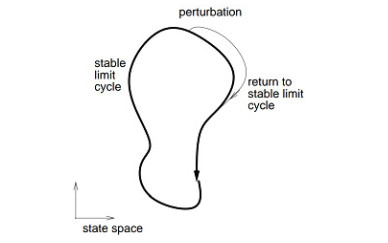









 DownLoad:
DownLoad:



